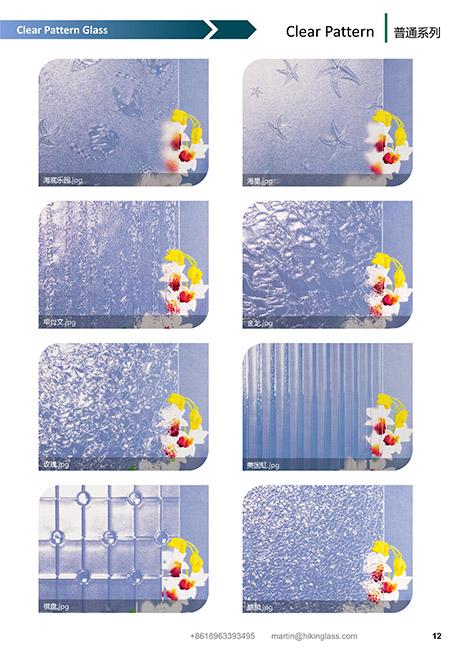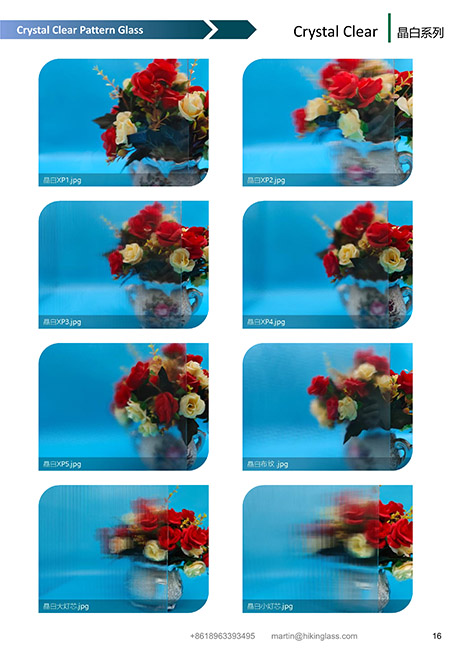Types of Pattern Glass: Textured vs. Colored
Pattern glass has long been cherished for its ability to add both functionality and aesthetic appeal to various settings. Among the different types of pattern glass, textured and colored glass stand out for their distinct characteristics and uses. This article delves into the differences, manufacturing processes, applications, and benefits of textured and colored pattern glass, providing a comprehensive understanding of these two popular varieties.

Textured Pattern Glass
Textured glass, also known as patterned or decorative glass, is created by impressing patterns into the glass during its production. This type of glass is renowned for its ability to diffuse light while providing a degree of privacy. Some common types of textured glass include frosted glass, Reeded Glass, ribbed glass, rain glass, and wavy glass[2,4].
Manufacturing Process
The manufacturing process of textured glass involves rolling molten glass between two rollers, one of which has a pattern etched into its surface. As the glass cools and solidifies, the pattern is permanently embossed onto its surface. This method allows for a wide variety of patterns and textures, from simple geometric designs to intricate floral motifs.
Applications
Textured glass is widely used in both residential and commercial settings. Common applications include:
Windows and Doors: Textured glass in windows and doors provides privacy while still allowing light to penetrate, making it ideal for bathrooms, entryways, and office partitions.
Furniture: It is often used in cabinet doors, tabletops, and shelving to add a decorative touch.
Architectural Features: Textured glass is popular for wall partitions and room dividers in open-plan spaces, offering both visual appeal and functional separation.
Decorative Elements: Vases, bowls, and light fixtures often feature textured glass to enhance their aesthetic appeal.
Colored Pattern Glass
colored glass, another prominent type of pattern glass, is distinguished by its vibrant hues and the ability to create visually striking designs. This type of glass can be transparent, translucent, or opaque, depending on the manufacturing process and the intended use.
Manufacturing Process
Colored glass is produced by adding metal oxides or other compounds to the glass mixture during the melting process. For example, adding cobalt oxide produces blue glass, while adding chromium oxide yields green glass. The color is uniformly distributed throughout the glass, ensuring consistent and long-lasting coloration. Stained glass, a well-known form of colored glass, involves adding colorants to molten glass or applying colored coatings to the surface[5].
Applications
Colored glass is used in a variety of decorative and functional contexts, including:
Windows: Stained glass windows are common in churches, cathedrals, and historic buildings, where they add color and artistry to the architecture.
Interior Design: Colored glass panels and tiles are used in kitchens, bathrooms, and living areas to create vibrant and eye-catching designs.
Lighting: Colored glass is often used in lampshades and light fixtures to produce warm, colored lighting effects.
Art and Craft: Colored glass is a favorite material among artists and craftsmen for creating jewelry, mosaics, and decorative items.
Comparison: Textured vs. Colored Glass
While both textured and colored glass offer unique benefits and aesthetic qualities, their differences lie in their visual effects, production techniques, and applications.
Visual Effects
Textured Glass: The primary feature of textured glass is its ability to diffuse light and create privacy. The patterns etched into the glass can range from subtle to bold, adding depth and dimension to the material.
Colored Glass: Colored glass stands out for its vibrant hues and the way it interacts with light. Depending on the level of transparency, colored glass can create a range of effects, from soft glows to vivid displays of color.
Production Techniques
Textured Glass: Produced by rolling molten glass with patterned rollers, textured glass is defined by its surface designs.
Colored Glass: Created by adding metal oxides to molten glass, colored glass incorporates pigments throughout its body or on its surface.
Applications and Uses
Textured Glass: Ideal for applications requiring privacy and light diffusion, such as bathroom windows, shower doors, and room dividers.
Colored Glass: Best suited for decorative and artistic applications, such as stained glass windows, colored glass tiles, and art pieces.
Benefits of Textured and Colored Glass
Both types of pattern glass offer unique benefits that cater to different needs and preferences.

Benefits of Textured Glass
Privacy: Textured glass obscures the view, making it ideal for areas where privacy is important without compromising on natural light.
Aesthetic Appeal: The various patterns available add a decorative element to functional items, enhancing their visual appeal.
Versatility: Textured glass can be used in a wide range of applications, from windows and doors to furniture and decorative items.
Benefits of Colored Glass
Vibrant Designs: The rich colors available in colored glass make it perfect for creating striking visual effects and artistic pieces.
Customization: Colored glass can be customized with different hues and levels of transparency, allowing for personalized designs.
Durability: The coloration in colored glass is typically long-lasting, ensuring that the vibrant appearance remains over time.
Conclusion
Textured and colored pattern glass both offer distinct advantages and aesthetic possibilities. Textured glass excels in providing privacy and diffusing light, making it suitable for practical applications in homes and offices. Colored glass, on the other hand, brings vibrant hues and artistic flair to various decorative and architectural projects. Understanding the differences and benefits of these two types of pattern glass can help in making informed choices for both functional and aesthetic purposes in various settings.
 English
English Russian
Russian




